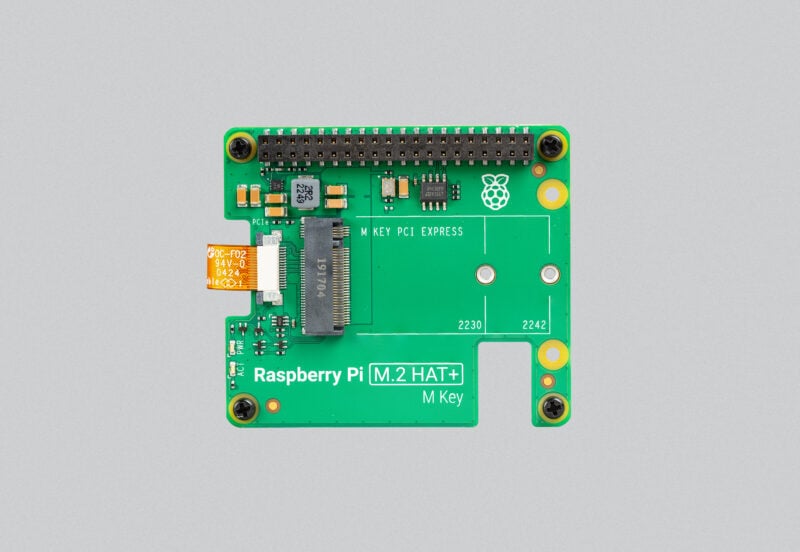Raspberry Pi launches $12 M.2 HAT+ for Raspberry Pi 5
Low-cost, high-speed storage for the new flagship.

Raspberry Pi has today released the $12 M.2 HAT+ for the Raspberry Pi 5 (yes, one is on the way for our review) with up to 500 MB/s data transfer, much faster than even the best micro SD cards can manage.
Designed to fit on top of the Raspberry Pi (unlike other third-party NVMe boards), the M.2 HAT+ is secured to the Raspberry Pi 5 using M2.5 standoffs and screws. The boards is connected to the PCIe connector for data and power, and the GPIO pins are accessible thanks to a 16mm stacking header. The standoffs also provide the necessary height to enable the Raspberry Pi Active Cooler and Argon's THRML 30 cooler to be used at the same time.
The M.2 HAT+ uses the new HAT+ standard, developed for the Raspberry Pi 5. This is the first update of the HAT standard since it was introduced with the Raspberry Pi B+ back in 2014. The HAT+ standard brings better power management options, a simpler EEPROM, and interestingly the possibility of stacking HAT+ boards on top of each other.
No software installation is required for M.2 HAT+, or any other M.2 NVMe drives. Raspberry Pi OS has baked-in support for these drives, but it would be prudent to update the firmware to ensure that you receive all of the latest features and updated drive compatibility.
| PCIe Interface | Officially 2.0, 3.0 can be set by the user |
| M.2 Support | M-key 2230 and 2242 |
| Power | Via PCIe FFC, up to 3 Amps |
| GPIO | Pass-through via included 16mm stacking header |
| Dimensions | 65 x 56.5 mm |
The Raspberry Pi 5 was launched back in September 2023 and went on sale in late October 2023. The Pi 5 introduced a dedicated PCIe interface to the traditional Raspberry Pi form factor — the Compute Module 4 carrier board had a PCIe slot long before the Pi 5. The PCie connection on the Pi 5 is where the display (DSI) connector used to be on previous models. The PCIe port uses an FFC (flexible flat cable) for a single-lane PCIe 2.0 bus. This 16-pin FFC provides the data and power connection for drives connected to the M.2 HAT+. Two pins are spare, and provide a "power enable" for device power and board detect used to wake any attached drives.
We've tested other M.2 NVMe drive boards. The first on the scene was Pineboard's (formerly Pineberry Pi) Hat Drive, next was Pimoroni's NVMe Base. Both of these boards supported PCIe 2.0, and could be pushed to support PCIe 3.0 speeds — something we will test once our review unit arrives. The problem that we faced with these boards concerns compatibility. NVMe drive support on the Raspberry Pi 5 was patchy. Some drives worked, others did not. The extra time afforded to Raspberry Pi for its M.2 HAT+ release means that many of the issues have been addressed, again we will be testing this.
The official Raspberry Pi M.2 HAT+ goes on sale today for $12 via approved resellers.
Get Tom's Hardware's best news and in-depth reviews, straight to your inbox.

Les Pounder is an associate editor at Tom's Hardware. He is a creative technologist and for seven years has created projects to educate and inspire minds both young and old. He has worked with the Raspberry Pi Foundation to write and deliver their teacher training program "Picademy".
-
SiberianHamster Personally I find the NVMe base positioning better, doesn't obstruct the cooler.Reply
